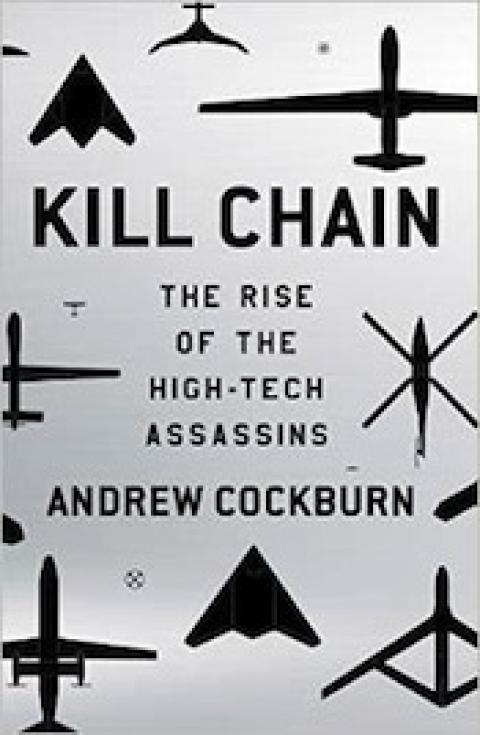Caveat emptor: Andrew Cockburn, the author of Kill Chain: the Rise of the High-Tech Assassins, is a friend of thirty-five years, so I am biased, proudly so in this case. While I know what Cockburn can do, I must admit I was literally blown away by this book. And I am no stranger to this subject, having worked as an engineer-analyst in the Office of the Secretary of Defense in the Pentagon for 28 years.
What makes Cockburn’s book so powerful, in my opinion, is not only his sourcing and detail (which are amazing), but the fact that he has written a book that is at once overwhelming in terms of information, yet so well written, it is accessible to the general reader. It is a page turner. He dissects the rise of drone warfare and examines its conduct in fascinating detail from the point of view of the targeteers in the CIA and the White House, to the controllers in front of video screens, and to the effects on the victims at the receiving end.
In so doing, he shows how the ideology of drone warfare is really old wine in a new bottle: it is a natural evolution of three interconnected mindsets: (1) the flawed ideas underpinning the now-discredited theory of strategic bombing in WWII; (2) the search for perfect information embodied in disastrous all-knowing, all-seeing electronic battlefield (starting with McNamara’s electronic line of Vietnam); and (3) the search for surgical precision in both conflict and coercive diplomacy embodied, for example, in the naive targeting theories underpinning the drug war and the escalate-the-pressure tactics of precision targeted sanctions. At the roots of all these theories, I would argue, is an unchanging three-part set of propositions woven together in the 1930s by the evangelical instructors in the Army Air Corps Tactical School. They preached the theory of victory thru airpower alone, and they believed that only strategic bombing could justify an independent Air Force on a par with the Army and the Navy, and with comparable or even higher budgets.
These future leaders of the AF constructed a seductive tautological argument, based on the fallacious assumptions of having extensive a priori knowledge of the enemy’s inner workings coupled to perfect combat intelligence. It remains unchanged to this day and goes like this: (1) The enemy is a physical system or network made up of critical linkages and nodes, be they ball bearing works in Schweinfurt, or Salafi fanatics in Iraq with access to cell phones and the internet, or tribal warlords in the hills of Afghanistan. (2) The enemy system can be reliably analyzed and understood from a distance, making it possible to exactly identify those specific nodes or links that are vital to the functioning of the adversary system, be it an industrial power like Germany, a tribal alliance in Yemen, or the financial links of a terrorist network or foreign oligarchy. (3) That technology provides the wherewithal to attack and destroy these vital nodes or links with precision strikes and thereby administer a mortal wound to the adversary.
In short, the conduct of war is an engineering problem: In the current lexicon of the Pentagon and its defense contractors, the enemy is a ‘systems of systems’ made up of high value targets (HVTs) that can be identified and destroyed without risk from a distance with unmanned systems. The reasoning is identical to that described in the preceding paragraph. Yet despite its stridently confident predictions of decisive precision effects, from the days of the Norden bombsight in B-17s to those of the Hellfire missile fired by drones, this theory has failed to perform as its evangelists predicted and are still predicting.
Viewing war as an engineering problem focuses on technology (which benefits contractors) and destructive physical effects, but ignores and is offset by the fundamental truth of war: Machines don’t fight wars, people do, and they use their minds. Our technology’s physical effects can be — and often are — offset by our opponent’s mental counters or initiatives, reflecting both his adaptability and unpredictability, and his moral strengths, like resolve and the will to resist. Combat history has proven this over and over that mental and moral effects can offset physical effects, for example, when the destruction of ball bearing factories did not have its predicted effects in WWII, when bicycles carrying 600 pounds of supplies were used to by pass destroyed bridges on the Ho Chi Minh Trail, and when the Serbs used microwave ovens to fool expensive anti-radiation missiles in Kosovo. And as Cockburn shows, this has proven true again in the ongoing war on terror, and its mirror image, the war on drugs.
Any one who doubts that this critique applies to drones used in a counter-terror strategy should be asked to explain the collapse of in Yemen — the place where drones reached their apotheosis as the centerpiece of American counter-terror strategy.
Cockburn has provided a highly readable, and logically devastating story, written from a bottom-up empirical perspective. He explains why our strategy in Yemen was doomed to fail, as indeed it has in recent weeks. His meticulously referenced historical and empirical research makes this book hard to pick apart. No doubt, there are some small errors of fact. For example, not all the drone/bombers deployed in ill starred Operation Aphrodite (which blew up JFK’s elder brother) in 1944 were B-24s as Cockburn incorrectly suggests; the operation also used B-17s. But I defy anyone to find a single thread or family of threads that can be used to unravel his tapestry.
Franklin “Chuck” Spinney is a former military analyst for the Pentagon and a contributor to Hopeless: Barack Obama and the Politics of Illusion, published by AK Press. He be reached at chuck_spinney@mac.com


Spread the word